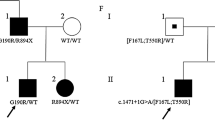Abstract
Based on previous reports the frequency of co-segregating recessive chloride channel (CLCN1) mutations in families with myotonic dystrophy type 2 (DM2) was suspected to be increased. We have studied the frequency of CLCN1 mutations in two separate patient and control cohorts from Germany and Finland, and for comparison in a German myotonic dystrophy type 1 (DM1) patient cohort. The frequency of heterozygous recessive chloride channel (CLCN1) mutations is disproportionally higher (5 %) in currently diagnosed DM2 patients compared to 1.6 % in the control population (p = 0.037), while the frequency in DM1 patients was the same as in the controls. Because the two genes segregate independently, the prevalence of CLCN1 mutations in the total DM2 patient population is, by definition, the same as in the control population. Our findings are, however, not based on the total DM2 population but on the currently diagnosed DM2 patients and indicate a selection bias in molecular diagnostic referrals. DM2 patients with co-segregating CLCN1 mutation have an increased likelihood to be referred for molecular diagnostic testing compared to DM2 patients without co-segregating CLCN1 mutation.
Similar content being viewed by others
References
Bachinski LL, Udd B, Meola G, Sansone V, Bassez G, Eymard B, Thornton CA, Moxley RT, Harper PS, Rogers MT, Jurkat-Rott K, Lehmann-Horn F, Wieser T, Gamez J, Navarro C, Bottani A, Kohler A, Shriver MD, Sallinen R, Wessman M, Zhang S, Wright FA, Krahe R (2003) Confirmation of the type 2 myotonic dystrophy (CCTG)n expansion mutation in patients with proximal myotonic myopathy/proximal myotonic dystrophy of different European origins: a single shared haplotype indicates an ancestral founder effect. Am J Hum Genet 73:835–848
Baumann P, Myllyla VV, Leisti J (1998) Myotonia congenita in northern Finland: an epidemiological and genetic study. J Med Genet 35:293–296
Brook JD, McCurrach ME, Harley HG, Buckler AJ, Church D, Aburatani H, Hunter K, Stanton VP, Thirion JP, Hudson T, et al. (1992) Molecular basis of myotonic dystrophy: expansion of a trinucleotide (CTG) repeat at the 3’ end of a transcript encoding a protein kinase family member. Cell 68:799–808
Charlet BN, Savkur RS, Singh G, Philips AV, Grice EA, Cooper TA (2002) Loss of the muscle-specific chloride channel in type 1 myotonic dystrophy due to misregulated alternative splicing. Mol Cell 10:45–53
Cho DH, Tapscott SJ (2007) Myotonic dystrophy: emerging mechanisms for DM1 and DM2. Biochimica et biophysica acta 1772:195–204
Day JW, Ricker K, Jacobsen JF, Rasmussen LJ, Dick KA, Kress W, Schneider C, Koch MC, Beilman GJ, Harrison AR, Dalton JC, Ranum LP (2003) Myotonic dystrophy type 2: molecular, diagnostic and clinical spectrum. Neurology 60:657–664
Deymeer F, Lehmann-Horn F, Serdaroglu P, Cakirkaya S, Benz S, Rudel R, Ozdemir C (1999) Electrical myotonia in heterozygous carriers of recessive myotonia congenita. Muscle Nerve 22:123–125
Duno M, Colding-Jorgensen E, Grunnet M, Jespersen T, Vissing J, Schwartz M (2004) Difference in allelic expression of the CLCN1 gene and the possible influence on the myotonia congenita phenotype. Eur J Hum Genet 12:738–743
Fu YH, Pizzuti A, Fenwick RG Jr, King J, Rajnarayan S, Dunne PW, Dubel J, Nasser GA, Ashizawa T, de Jong P, et al. (1992) An unstable triplet repeat in a gene related to myotonic muscular dystrophy. Science (New York, NY) 255:1256–1258
George AL Jr, Crackower MA, Abdalla JA, Hudson AJ, Ebers GC (1993) Molecular basis of Thomsen’s disease (autosomal dominant myotonia congenita). Nat Genet 3:305–310
Kimura T, Nakamori M, Lueck JD, Pouliquin P, Aoike F, Fujimura H, Dirksen RT, Takahashi MP, Dulhunty AF, Sakoda S (2005) Altered mRNA splicing of the skeletal muscle ryanodine receptor and sarcoplasmic/endoplasmic reticulum Ca2+-ATPase in myotonic dystrophy type 1. Hum Mol Genet 14:2189–2200
Koch MC, Steinmeyer K, Lorenz C, Ricker K, Wolf F, Otto M, Zoll B, Lehmann-Horn F, Grzeschik KH, Jentsch TJ (1992) The skeletal muscle chloride channel in dominant and recessive human myotonia. Science (New York, NY) 257:797–800
Lamont PJ, Jacob RL, Mastaglia FL, Laing NG (2004) An expansion in the ZNF9 gene causes PROMM in a previously described family with an incidental CLCN1 mutation. J Neurol Neurosurg Psychiatry 75:343
Lin X, Miller JW, Mankodi A, Kanadia RN, Yuan Y, Moxley RT, Swanson MS, Thornton CA (2006) Failure of MBNL1-dependent post-natal splicing transitions in myotonic dystrophy. Hum Mol Genet 15:2087–2097
Liquori CL, Ricker K, Moseley ML, Jacobsen JF, Kress W, Naylor SL, Day JW, Ranum LP (2001) Myotonic dystrophy type 2 caused by a CCTG expansion in intron 1 of ZNF9. Science (New York, NY) 293:864–867
Mahadevan M, Tsilfidis C, Sabourin L, Shutler G, Amemiya C, Jansen G, Neville C, Narang M, Barcelo J, O’Hoy K, et al. (1992) Myotonic dystrophy mutation: an unstable CTG repeat in the 3’ untranslated region of the gene. Science (New York, NY) 255:1253–1255
Mahadevan MS, Yadava RS, Yu Q, Balijepalli S, Frenzel-McCardell CD, Bourne TD, Phillips LH (2006) Reversible model of RNA toxicity and cardiac conduction defects in myotonic dystrophy. Nat Genet 38:1066–1070
Mankodi A, Takahashi MP, Jiang H, Beck CL, Bowers WJ, Moxley RT, Cannon SC, Thornton CA (2002) Expanded CUG repeats trigger aberrant splicing of ClC-1 chloride channel premRNA and hyperexcitability of skeletal muscle in myotonic dystrophy. Mol Cell 10:35–44
Maurage CA, Udd B, Ruchoux MM, Vermersch P, Kalimo H, Krahe R, Delacourte A, Sergeant N (2005) Similar brain tau pathology in DM2/ PROMM and DM1/Steinert disease. Neurology 65:1636–1638
Moxley RT 3rd, Meola G, Udd B, Ricker K (2002) Report of the 84th ENMC workshop: PROMM (proximal myotonic myopathy) and other myotonic dystrophy-like syndromes: 2nd workshop. 13–15th October, 2000, Loosdrecht, The Netherlands. Neuromuscul Disord 12:306–317
Papponen H, Toppinen T, Baumann P, Myllyla V, Leisti J, Kuivaniemi H, Tromp G, Myllyla R (1999) Founder mutations and the high prevalence of myotonia congenita in northern Finland. Neurology 53:297–302
Philips AV, Timchenko LT, Cooper TA (1998) Disruption of splicing regulated by a CUG-binding protein in myotonic dystrophy. Science (New York, NY) 280:737–741
Ranum LP, Day JW (2004) Myotonic dystrophy: RNA pathogenesis comes into focus. Am J Hum Genet 74:793–804
Savkur RS, Philips AV, Cooper TA, Dalton JC, Moseley ML, Ranum LP, Day JW (2004) Insulin receptor splicing alteration in myotonic dystrophy type 2. Am J Hum Genet 74:1309–1313
Sun C, Tranebjaerg L, Torbergsen T, Holmgren G, Van Ghelue M (2001) Spectrum of CLCN1 mutations in patients with myotonia congenita in Northern Scandinavia. Eur J Hum Genet 9:903–909
Udd B, Krahe R, Wallgren-Pettersson C, Falck B, Kalimo H (1997) Proximal myotonic dystrophy – a family with autosomal dominant muscular dystrophy, cataracts, hearing loss and hypogonadism: heterogeneity of proximal myotonic syndromes? Neuromuscul Disord 7:217–228
Udd B, Meola G, Krahe R, Thornton C, Ranum L, Day J, Bassez G, Ricker K (2003) Report of the 115th ENMC workshop: DM2/PROMM and other myotonic dystrophies. 3rd Workshop, 14–16 February 2003, Naarden, The Netherlands. Neuromuscul Disord 13:589–596
Udd B, Meola G, Krahe R, Thornton C, Ranum LP, Bassez G, Kress W, Schoser B, Moxley R (2006) 140th ENMC International Workshop: Myotonic Dystrophy DM2/PROMM and other myotonic dystrophies with guidelines on management. Neuromuscul Disord 16:403–413
Author information
Authors and Affiliations
Corresponding author
Electronic supplementary material
Rights and permissions
About this article
Cite this article
Suominen, T., Schoser, B., Raheem, O. et al. High frequency of co-segregating CLCN1 mutations among myotonic dystrophy type 2 patients from Finland and Germany. J Neurol 255, 1731–1736 (2008). https://doi.org/10.1007/s00415-008-0010-z
Received:
Revised:
Accepted:
Published:
Issue Date:
DOI: https://doi.org/10.1007/s00415-008-0010-z




